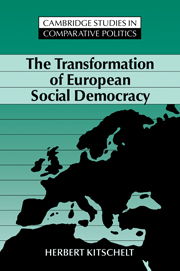Book contents
- Frontmatter
- Contents
- List of tables and figures
- Preface
- Glossary of political parties by country
- Introduction
- 1 Social structure and collective preference formation: Opportunities for left party strategy in the 1970s and 1980s
- 2 Class structure and left party performance
- 3 Political economy and left party fortunes
- 4 Social democratic strategy and electoral competition
- 5 Internal politics in socialist parties: Preference formation, aggregation, and strategic choice
- 6 The socialist discourse: Political semantics and party strategy
- 7 Social democracy in decline? Analytical and normative extensions of the argument
- References
- Index
4 - Social democratic strategy and electoral competition
Published online by Cambridge University Press: 08 January 2010
- Frontmatter
- Contents
- List of tables and figures
- Preface
- Glossary of political parties by country
- Introduction
- 1 Social structure and collective preference formation: Opportunities for left party strategy in the 1970s and 1980s
- 2 Class structure and left party performance
- 3 Political economy and left party fortunes
- 4 Social democratic strategy and electoral competition
- 5 Internal politics in socialist parties: Preference formation, aggregation, and strategic choice
- 6 The socialist discourse: Political semantics and party strategy
- 7 Social democracy in decline? Analytical and normative extensions of the argument
- References
- Index
Summary
In the preceding chapters, I primarily explored the extent to which class structure, economic performance, and political-economic institutions affect the electoral support of socialist parties. I considered the role of social democratic party strategy in the mobilization of electoral constituencies only indirectly when I examined whether left parties strategically act on a class trade-off (Chapter 2), choose to join or abstain from governments, manufacture political business cycles, or manipulate institutions of interest intermediation or of the welfare state to their electoral advantage (Chapter 3). In all these instances, there is little evidence that parties were able to act strategically or, if they did, their actions often did not yield the desired results. For example, most socialist governments failed to bring about political business cycles and even where they were successful, they were likely to lose elections. Similarly, corporatist intermediation and comprehensive welfare states in the 1980s had ambiguous or clearly negative consequences for social democratic electoral support. In the 1980s, several socialist governments engaged in successful economic austerity policies that eventually cost them votes but kept their main bourgeois competitors weak. Without examining the strategic context of party competition, however, one cannot explain why some socialist parties were able to choose this strategy and win executive office.
In this chapter, therefore, I will examine the direct impact of left parties' strategic appeals on voters' electoral choices. With the decline of party identification and class voting (Franklin et al. 1992), an increasing share of the electorate becomes sensitive to the explicit political messages and appeals issued by parties in the competitive game.
- Type
- Chapter
- Information
- The Transformation of European Social Democracy , pp. 112 - 206Publisher: Cambridge University PressPrint publication year: 1994

